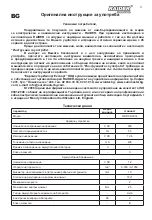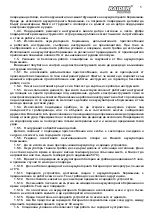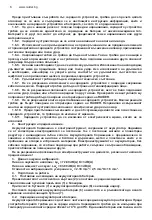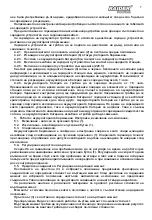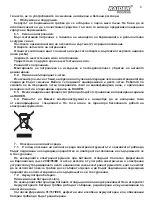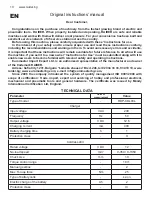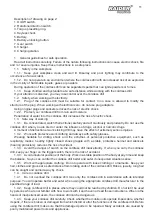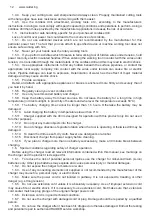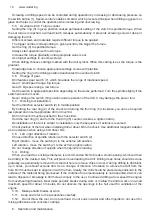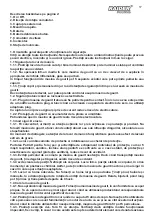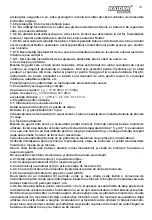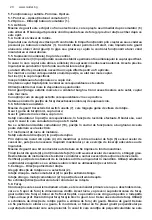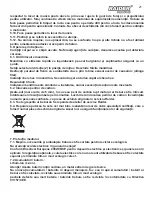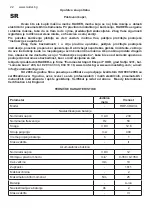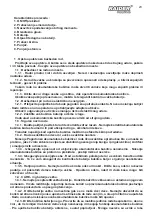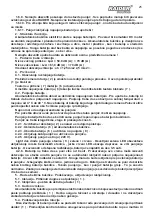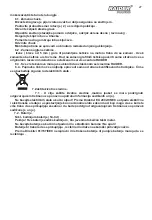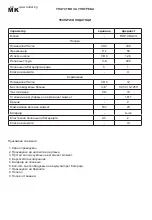
13
1.6.9. Do not try to dismantle the charger. All repairs are to be made by an authorized RAIDER service
workshop. Improper charger assembly may cause electric shock or fire.
1.6.10. Disconnect the charger from a power supply before starting any maintenance or cleaning.
1.6.11. Disconnect the charger from mains network when it is not in use.
2. Construction and use.
Drill is a battery-powered tool. Drive consists of DC commutator motor with permanent magnets and
planetary gear. Drill is designed for screwing in and out screws and bolts in wood, metal and plastics and
for drilling holes in these materials. Cordless, battery-powered power tools are especially useful for works
in interior furnishing, adaptation of premises etc.
Use the power tool according to the manufacturer’s instructions only.
3. Noise level and vibration parameters.
Sound pressure: Lp
A
= 72.89 dB(A) K=3 dB(A)
Sound power: Lw
A
= 83.89 dB(A) K=3 dB(A)
Vibration acceleration: a
h
= 1.25m/s
2
< 2,5 m/s
2
, K=1.5 m/s
2
.
4. Preparation for operation.
4.1. Inserting and removing the battery.
Set the direction selector switch (2) in middle position
Push buttons (7) and slide the battery (6) down.
Insert charged battery (6) into the handle holder. You should hear when the lock buttons (7) snap.
4.2. Charging the battery.
Drill is supplied with partially charged battery. Charge the battery full before use. Charging the battery
should be carried out in temperature between 4°C to 40°C. New battery, or one that have not been used
for a long time, will reach full efficiency after approximately 5 charge/discharge cycles.
The mains voltage must match the voltage on the charger rating plate.
Always check technical condition of the charger, charging station and power cord before starting to
charge.
When charging the battery, use only the charger and the charging station supplied with the drill.
Do not expose the charger and charging station to rain or splashing.
4.2.1. Set the direction selector switch (2) in middle position.
4.2.2. Remove the battery (6) from the drill.
4.2.3. Insert the battery (6) into the socket of the charging station (9).
4.2.4. Connect charger power cord to the socket of the charging station.
4.2.5. Connect the charger to mains socket (220V).
Two diodes on the charger (9) light up: green and red. Green diode indicates connection of the charger
to mains, red diode indicates the battery is being charged. Depending on battery discharge level, the
battery will be charged after 1 hours.
4.2.6. Do not charge the battery for more than 1.5 hours. Exceeding this time limit may cause damage
to battery cells. Charger will not turn off automatically when the battery is full. Red diode on the charger
will remain lit. Disconnect power supply before removing the battery from the charger. Avoid consecutive
short chargings. Do not charge the battery after short use of the drill. The battery and the charger heat up
during charging. This is normal. Significant decrease of the period between chargings indicates the battery
is used up and should be replaced.
5. Operation and settings. Switching on. Switching off.
5.1. Switching on - press the switch button (1).
5.2. Switching off - release the switch button (1).
5.3. Spindle brake.
Drill is equipped with electronic brake, which stops the spindle immediately after the switch (6) is
released. The brake ensures precision when screwing or drilling and prevents free spindle rotation after
it is switched off.
5.4. Rotational speed control.



